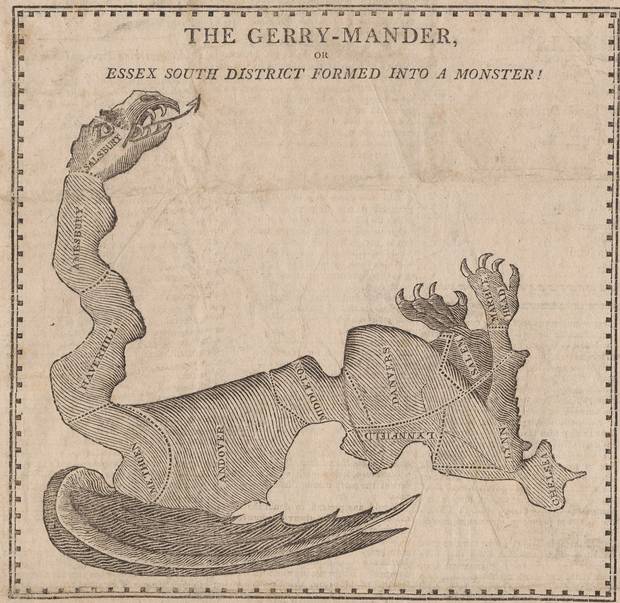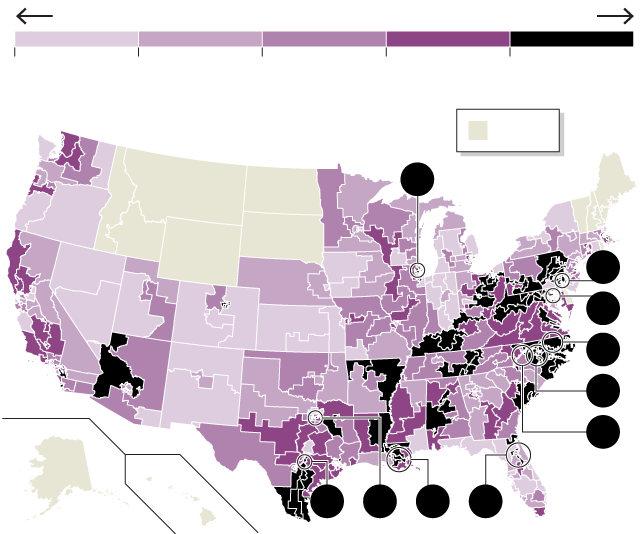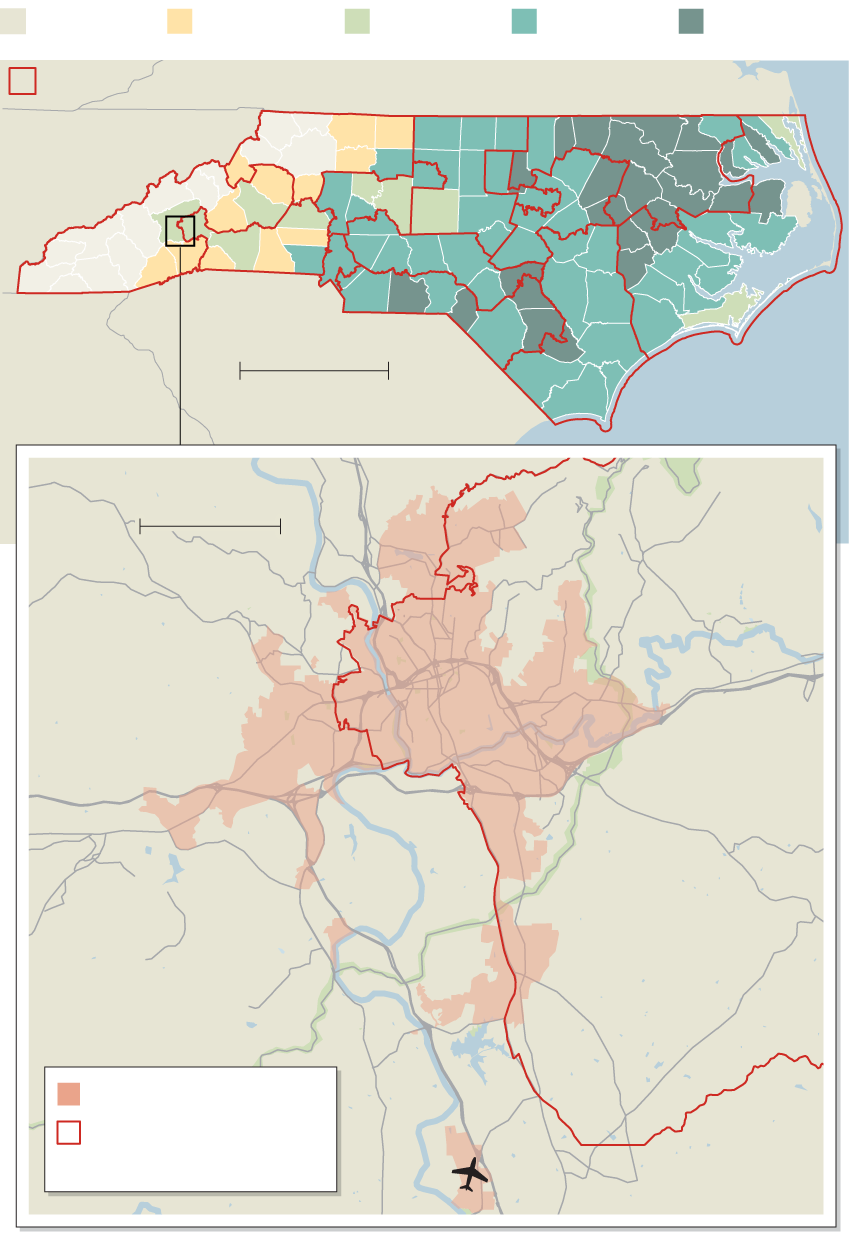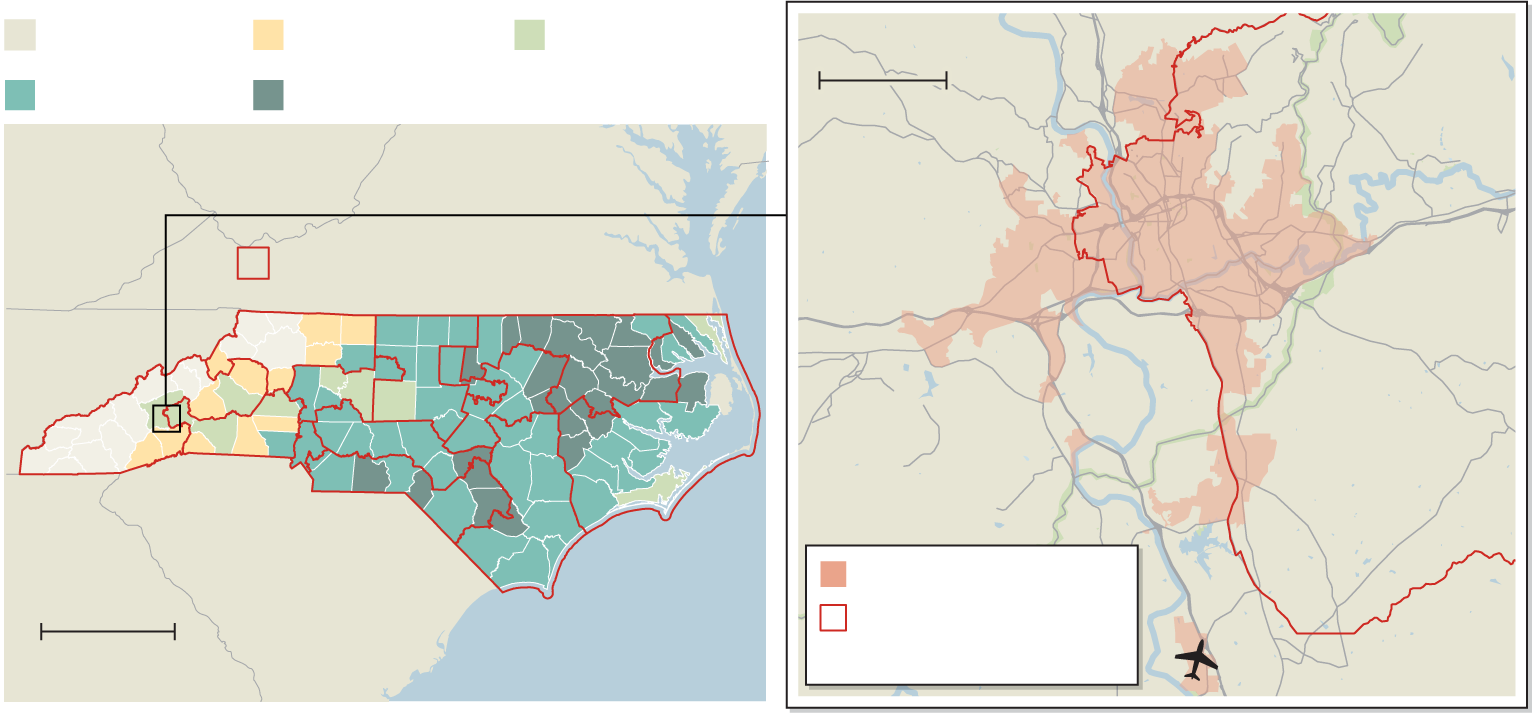
A year after governor Elbridge Gerry’s radical (and self-serving) redrawing of the Massachusetts political landscape inspired the Boston Gazette cartoonist’s ‘Gerry-Mander,’ this version appeared in the April 2, 1813, edition of the Salem Gazette. Here’s the original page; you can also read the accompanying editorial below.
Donald Trump says the election is rigged. His enemies are trying to steal it from him. That's nonsense, of course. Out-and-out cheating at the ballot box is vanishingly rare in the United States, thanks to a host of safeguards.
But he's right in one sense.
American politics is rigged. Both parties do the rigging, and they do it in plain sight, shamelessly and legally and even democratically.
They draw the boundaries of the country's electoral districts to their own advantage, grouping voters in a way that gives their party the greatest number of wins in Congress and in state legislatures.
Instead of the voters choosing the politicians, the politicians, in effect, choose the voters.
The process is called gerrymandering and it's as old as the United States. Patrick Henry, a hero of the American Revolution, is said to have colluded in redrawing a Virginia district in an attempt to thwart his rival, James Madison.
The word itself goes back to 1812, when the administration of Elbridge Gerry, governor of Massachusetts, created a revised map of electoral districts for the state Senate.
The new districts were designed quite deliberately to help his Democratic-Republicans, forerunner of today's Democrats, win as many seats as possible, and his Federalist rivals as few. One new district in the Boston area was thought to resemble a salamander. A cartoonist for The Boston Gazette, Elkanah Tisdale, took note and sketched a mythical salamander-like beast: "the Gerry-Mander." Ever since, the act of drawing contorted electoral districts to tilt elections has been known as gerrymandering.
Of course, American politicians have evolved since Governor Gerry drew his beastly map. These days, they're a lot better at it.
Thanks to advances in map-drawing software and ready access to online data about voters, U.S. political parties have turned the crude craft of gerrymandering into a science. The districts they draw often break every common-sense rule of district-making. Instead of following natural geographical or political boundaries, such as rivers or county lines, they dodge and meander all over the place to gather like-minded voters together (a technique called packing) or split them apart (cracking).
Many of the resulting districts make Governor Gerry's look compact by comparison. One in Illinois is nicknamed the "earmuff district"; another, in Texas, "the upside-down elephant"; still another, in Pennsylvania, has been said to resemble "Goofy kicking Donald Duck." One judge said that a Maryland congressional district, this one engineered by Democrats, reminded him of "a broken-winged pterodactyl, lying prostrate across the centre of the state."
Geography run amok
These are The Washington Post's 'gerrymander index' scores for the 113th U.S. Congress, which met from 2013 to 2015. The newspaper calculated the scores by comparing the ratio of the area of each electoral district to the area of a circle with the same perimeter. The Post did not include states with only one or two districts.

Less gerrymandered
More gerrymandered
40
65
75
80
85
=N/A
8
4
2
5
7
1
6
9
10
3

Less gerrymandered
More gerrymandered
40
65
75
80
85
=N/A
8
4
2
5
7
1
6
9
10
3

Less gerrymandered
More gerrymandered
40
65
75
80
85
=N/A
8
4
2
5
7
1
6
9
10
3

Less gerrymandered
More gerrymandered
40
65
75
80
85
=N/A
8
4
2
5
7
1
6
9
10
3
First casualty: moderation
Gerrymandering's critics say that it hardens the political divisions that are so evident in this season of Trump. When parties draw safe, secure seats for themselves, they don't have to reach out to moderate voters. The most important election becomes the primary, where party voters select the party's candidate for the general election. Primary voters tend to be party activists – leaning to the right of the Republican party and the left of the Democratic. Succeeding in the all-important primary means appealing to the extremes.
"Nobody has to compromise, because they know that their constituency is going to support them," says Jane Pinsky, director of the North Carolina Coalition for Lobbying and Government Reform. In her state, which has seen bitter struggles this year over issues such as a law that governs washroom access for transgender people in public buildings, "We've become increasingly partisan. The whole culture has become angry and vicious. It mirrors what's happened on a national level."
Creative map-drawing can widen racial divides, too. Many oddly shaped districts sprang from civil-rights legislation designed to increase black representation in the halls of power. Their boundaries reach this way and that to gather in African-American voters and create so-called majority-minority districts that tend to elect black representatives, usually Democratic. The effect, though, is to bleach surrounding districts white. That suits Republicans, because those districts often tend to vote for them. The result has been what was once called an unholy alliance between white Republicans and black Democrats.
Politics and race in North Carolina
Here's how the percentage of black residents across North Carolina stacked up against the congressional districts in 2013. Redrawn boundaries skirt around Asheville, N.C., which has a more heavily Democratic population than other more rural, Republican-leaning counties in the district it previously belonged to.

11 to 34
0.40 to 3.0
34 to 62%
3.0 to 5.9
5.9 to 11
2016 electoral districts
0
150
KM
0
5
KM
Asheville
DISTRICT 11
DISTRICT 10
Asheville city limits
2016 electoral
district boundary

0.40 to 3.0
3.0 to 5.9
5.9 to 11
0
5
11 to 34
34 to 62%
KM
Asheville
2016 electoral districts
DISTRICT 11
DISTRICT 10
Asheville city limits
0
150
2016 electoral
district boundary
KM

0.40 to 3.0
3.0 to 5.9
5.9 to 11
11 to 34
34 to 62%
2016 electoral districts
0
150
KM
0
5
KM
Asheville
DISTRICT 11
DISTRICT 10
Asheville city limits
2016 electoral
district boundary

0.40 to 3.0
3.0 to 5.9
5.9 to 11
0
5
11 to 34
34 to 62%
KM
Asheville
2016 electoral districts
DISTRICT 11
DISTRICT 10
Asheville city limits
0
150
2016 electoral
district boundary
KM
A good place to see how gerrymandering works is Asheville, a city of about 90,000 in North Carolina's mountainous western corner. Every 10 years, when new census information comes out, state governments are required to look at the new data and redraw districts so that they have roughly the same number of voters. It's called redistricting and it's supposed to ensure that each person's vote carries similar weight.
In practice, it is gerrymandering time.
When the results of the 2010 census appeared, Republicans were in control of the state legislature – so they were the mapmakers. They took maximum advantage.
Asheville had been at the heart of the 11th Congressional District. The city is a liberal bastion in conservative country, the kind of place where bumper stickers read "Jesus Saves, Buddha Recycles," the local spice emporium sells alderwood-smoked sea salt, and affluent retirees come to enjoy a glass of Pumpkin Up the Volume ale at the Wicked Weed brew pub.
It was represented by Heath Shuler, a six-foot-two former football star. He was a conservative Blue Dog Democrat, opposing gun control, same-sex marriage and abortion, but moderate enough to work with opponents to get things done in Congress. To put the boots to Mr. Shuler, the mapmakers simply carved a big part of heavily Democratic Asheville out of the 11th, leaving the district mainly rural and overwhelmingly Republican. With the writing on the wall, Mr. Shuler decided not to run for a fourth two-year term.
His replacement, Mark Meadows, is a rock-ribbed Tea Party conservative. He joined many fellow right-wingers – and Mr. Trump – in their campaign of lies and innuendo about Barack Obama's citizenship. "We're going to send Mr. Obama home to Kenya or wherever it is," he said at a 2012 rally.
Central Asheville, meanwhile, ended up in the rejigged 10th district, where incumbent Republican Patrick McHenry was comfortable enough in his still very conservative district to absorb the infusion of urban Democrats and keep his seat.
"We got carved up," says Asheville Mayor Esther Manheimer, a Democrat. "We used to be part of a district that a Democrat could win."
In a trick called "double bunking," or sometimes "scorpions in a bottle," the North Carolina mapmakers even put two Democratic state legislators in the same district, forcing one to drop out of the 2012 election.
Tough luck, say the Republicans, who had seen the opposing party lord it over them for decades when North Carolina was solidly Democratic. Asked if his party gerrymandered districts to hurt the Democrats, local official Jeff Foster says, "Sure. I also think they did it to us for 100 years."
The Republicans got their revenge. North Carolina, a closely watched swing state, split almost evenly in the 2014 midterm congressional voting: 51 per cent Republican, 49 per cent Democrat. Yet the Republicans took 10 seats in the U.S. House of Representatives, the Democrats just three.
In a candid moment, Republican state legislator David Lewis said the party would have gone further if it could have. "I propose that we draw the maps to give a partisan advantage to 10 Republicans and three Democrats, because I do not believe it's possible to draw a map with 11 Republicans and two Democrats," he said during debate at a legislative committee.
The Republican success at sewing up North Carolina was part of a nationwide push. In his new book, Ratf**ked: The True Story Behind the Secret Plan to Steal America's Democracy, journalist David Daley, former editor-in-chief of Salon, shows how, after losing the White House to Mr. Obama in 2008, the GOP struck back by launching a sophisticated campaign to seize control of state governments, thus giving it the power to gerrymander congressional districts.
Thanks to all the data that party operatives now have about voter preferences and attitudes, they could draw detailed, block-by-block maps to almost guarantee a win for their candidates. As Mr. Daley writes, "The same computer algorithms that recommend your next purchase on Amazon and know the exact Netflix show you want to binge-watch can also determine, in this time of hardened partisanship, how you are likely to vote."
Aimed at painting the electoral map Republican red, the effort was called REDMAP, and it worked like a charm. Republicans poured resources into state races and took many legislatures and governorships, then drew new GOP-friendly districts from North Carolina to Wisconsin.
It was so successful that the Democrats are copying it. This week, they announced that they are establishing the National Democratic Redistricting Committee, headed by former attorney-general Eric Holder, to prepare to win back ground for the party in the next round of electoral mapmaking after the 2020 census. Mr. Obama himself will get involved after he leaves the White House.
What can be done
Is there hope for ending this peculiar form of American madness? Not that much, sad to say. A handful of states, including California and Idaho, have done the sensible thing and given the job of redistricting to an independent commission. That's the way it works in Canada, where each province has a commission headed by a judge.
"The United States is the only advanced democracy in the world where politicians directly participate in the districting process," says a website, End Gerrymandering, that tracks the issue.
In the meantime, lawsuits have managed to alter some of the worst gerrymanders, at least those drawn on racial lines. A court ruling last February forced North Carolina to redraw the notorious 12th Congressional District, a bizarre squiggle, 120 miles long but just 20 miles wide, that ran along the I-85 interstate to gather up black voters who live near the highway corridor. One legislator joked that the district was so narrow that, if you drove a car through it with the doors open, you would kill every voter.
But judges have been more reluctant to outlaw districts drawn for solely partisan reasons. Legislators themselves naturally resist handing redistricting to the courts or to impartial commissioners in the first place: If they did, they would lose a power that they have enjoyed since Elbridge Gerry's time. And what a magical power it is. American politicians can draw voting boundaries and influence election results more or less at their whim. While tut-tutting over Mr. Trump's rants about rigged elections, they're busily rigging districts left and right. Expect them to keep doing it as long as they can.
Marcus Gee is a Globe and Mail columnist.
Follow him on Twitter: @marcusbgee
AMERICAN HISTORY
'Arise, then, injured Citizens! Turn out! Turn out!'

This editorial appeared on the front page of the Salem Gazette ahead of a Massachusetts state Senate election in 1813, when the Federalist party won control back from the Democratic-Republicans who had created the infamous 'Gerry-Mander' district.
FEDERALISTS! FOLLOWERS OF WASHINGTON!
AGAIN behold and shudder at the exhibition of this terrific Dragon, brought to swallow and devour your liberties and equal Rights. Unholy party spirit and inordinate love of power gave it birth; –your patriotism and hatred of tyranny must by one vigorous struggle [to] strangle it in its infancy. The iniquitous Law, which cut up and severed this Commonwealth into Districts, is kindred to the arbitrary deeds of NAPOLEON when he partitioned the territories of innocent nations to suit his sovereign will. This Law inflicted a grievous wound on the Constitution, –it in fact subverts and changes our Form of Government, which ceases to be Republican as long as an Aristocratic HOUSE OF LORDS under the form of a Senate tyrannizes over the People, and silences and stifles the voice of the Majority.
When Tyranny and arbitrary Power thus make inroads upon the Rights of the People, what becomes the duty of the citizen? Shall he submit quietly and ignominiously to the decrees of Usurpers? Are the citizens of this Republic less jealous of their rights than their ancestors? Will you, then, permit at Party to disenfranchise the People, –to convert the Senate Chamber into a Fortress in which ambitious office-seekers may entrench themselves and set at defiance the frowns of the People? No, –this usurping Faction must be dislodged from its strong-hold.
Arise, then, injured Citizens! Turn out! Turn out! let Monday Next be the day of your Emancipation – by one manful Struggle reclaim your usurped Rights – and frown into obscurity those audacious men who unblushingly boasted –“We have secured the Senate for ten years, and should have been fools if we had not done it.” Prove on election day that the Folly of their men is equal to their want of honesty and contempt of the People. Elect patriots who will be loyal to the Constitution, and faithful to the interests of the State, –men who will harmonize with our illustrious STRONG, –and who will not sell our Drafted Soldiery, like Hessians, to any Foreign Power.
STATES OF PLAY: THE U.S. ELECTION, ON THE GROUND
Mini-doc: Why is this one Pennsylvania county so fond of Trump?
6:15




